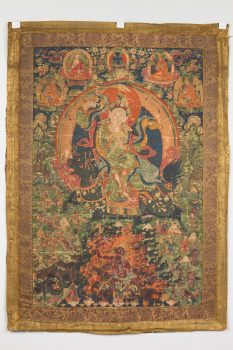Central Tibet
1790-1805


Central Tibet
1790-1805


This painting is a wonderful example of later central-Tibetan painting, essentially the continuation of a style known as New Menri under the patronage of the Dalai lama and his court. The deities are set into a landscape with the horizon in the upper half of the painting and snow-capped mountains in the foreground, as if one were looking at Tibet from the south. The flower foliage flanking the teachers in the upper area and the clouds with colored fringes surrounding the central deity’s halo are typical for this style. Particularly remarkable are the gilded areas, in which the gold is applied with extremely sophisticated detail in relief. Although placed firmly in the context of the Geluk Tibetan Buddhist tradition—the two teachers to the sides likely representing the Eighth Dalai Lama, Jamphel Gyatso (1758–1804), and the Fourth/Seventh Panchen Lama, Lobzang Tenpa Nyima (1782–1853)—the central goddess and the deity below her have yet to be identified. Both riding a yak, they might represent two modes of the same goddess. The peaceful form is white, wears traditional Tibetan dress, and holds a divination arrow and a mirror, while the wrathful form is of dark-red color, wears both gold and bone jewelry and a yak skin cape, and holds a flayed human skin and a dagger.
A kind of energy that can be used, individually and collectively, to effect change.
The transmission of teachings from one generation to the next, from teacher to student, traced all the way back to the Buddha without interruption. A complete lineage is essential in Tantric Buddhist practices as it makes the blessings of the teaching more powerful.
Prescribed practices that carry symbolic meaning and value within a specific tradition and are intended to attain a desired outcome. Rituals are usually done as part of a ceremony or regular routine.
Hindu gods (deva) are thought to be manifestations of the absolute, or Brahman. The goddesses (devi) are considered manifestations of the Great Mother Goddess (Mahadevi), who is seen as the counterpart to Brahman.
Today, Tibetans primarily inhabit the Tibetan Plateau, situated between the Himalayan mountain range and the Indian subcontinent to the west, Chinese cultural regions to the east, and Mongolian cultural regions to the northeast. During the 7th to 9th century, Tibetan rulers expanded their empire across Central Asia, and established Buddhism as the state religion.
Get the latest news and stories from the Rubin, plus occasional information on how to support our work.